Moderate-resolution imaging spectroradiometer
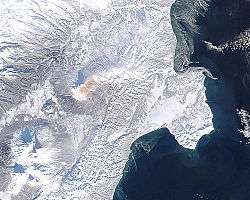


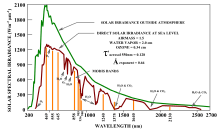
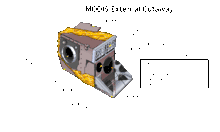
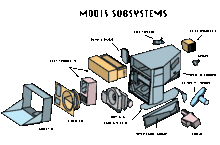

The moderate-resolution imaging spectroradiometer (MODIS) is a payload scientific instrument built by Santa Barbara Remote Sensing[1] that was launched into Earth orbit by NASA in 1999 on board the Terra (EOS AM) Satellite, and in 2002 on board the Aqua (EOS PM) satellite. The instruments capture data in 36 spectral bands ranging in wavelength from 0.4 µm to 14.4 µm and at varying spatial resolutions (2 bands at 250 m, 5 bands at 500 m and 29 bands at 1 km). Together the instruments image the entire Earth every 1 to 2 days. They are designed to provide measurements in large-scale global dynamics including changes in Earth's cloud cover, radiation budget and processes occurring in the oceans, on land, and in the lower atmosphere. MODIS utilizes four on-board calibrators in addition to the space view in order to provide in-flight calibration: solar diffuser (SD), solar diffuser stability monitor (SDSM), spectral radiometric calibration assembly (SRCA), and a v-groove black body.[2] MODIS has used the marine optical buoy for vicarious calibration. MODIS is succeeded by the VIIRS instrument on board the Suomi NPP satellite launched in 2011 and future Joint Polar Satellite System (JPSS) satellites.
The MODIS characterization support team (MCST) is dedicated to the production of high-quality MODIS calibrated product which is a precursor to every geophysical science product. A detailed description of the MCST mission statement and other details can be found at MCST Web.[3]
Applications
With its low spatial resolution but high temporal resolution, MODIS data is useful to track changes in the landscape over time. Examples of such applications are the monitoring of vegetation health by means of time-series analyses with vegetation indices,[4] long term land cover changes (e.g. to monitor deforestation rates),[5][6][7][8] global snow cover trends,[9][10] water inundation from pluvial, riverine, or sea level rise flooding in coastal areas,[11] change of water levels of major lakes such as the Aral Sea,[12][13] and the detection and mapping of wildland fires in the United States. The United States Forest Service's Remote Sensing Applications Center analyzes MODIS imagery on a continuous basis to provide information for the management and suppression of wildfires.[14]
Specifications
| Specifications | |
|---|---|
| Orbit | 705 km, 10:30 a.m. descending node (Terra) or 1:30 p.m. ascending node (Aqua), sun-synchronous, near-polar, circular |
| Scan rate | 20.3 rpm, cross track |
| Swath | 2330 km (cross track) by 10 km (along track at nadir) |
| Dimensions | |
| Telescope | 17.78 cm diam. off-axis, afocal (collimated), with intermediate field stop |
| Size | 1.0 × 1.6 × 1.0 m |
| Weight | 228.7 kg |
| Power | 162.5 W (single orbit average) |
| Data rate | 10.6 Mbit/s (peak daytime); 6.1 Mbit/s (orbital average) |
| Quantization | 12 bits |
| Spatial Resolution | 250 m (bands 1–2) 500 m (bands 3–7) 1000 m (bands 8–36) |
| Temporal Resolution | 1-2 days [15] |
| Design life | 6 years |
MODIS bands
| Band | Wavelength (nm) |
Resolution (m) |
Primary Use |
|---|---|---|---|
| 1 | 620–670 | 250 | Land/Cloud/Aerosols Boundaries |
| 2 | 841–876 | 250 | |
| 3 | 459–479 | 500 | Land/Cloud/Aerosols Properties |
| 4 | 545–565 | 500 | |
| 5 | 1230–1250 | 500 | |
| 6 | 1628–1652 | 500 | |
| 7 | 2105–2155 | 500 | |
| 8 | 405–420 | 1000 | Ocean Color/ Phytoplankton/ Biogeochemistry |
| 9 | 438–448 | 1000 | |
| 10 | 483–493 | 1000 | |
| 11 | 526–536 | 1000 | |
| 12 | 546–556 | 1000 | |
| 13 | 662–672 | 1000 | |
| 14 | 673–683 | 1000 | |
| 15 | 743–753 | 1000 | |
| 16 | 862–877 | 1000 | |
| 17 | 890–920 | 1000 | Atmospheric Water Vapor |
| 18 | 931–941 | 1000 | |
| 19 | 915–965 | 1000 | |
| Band | Wavelength (µm) |
Resolution (m) |
Primary Use |
| 20 | 3.660–3.840 | 1000 | Surface/Cloud Temperature |
| 21 | 3.929–3.989 | 1000 | |
| 22 | 3.929–3.989 | 1000 | |
| 23 | 4.020–4.080 | 1000 | |
| 24 | 4.433–4.498 | 1000 | Atmospheric Temperature |
| 25 | 4.482–4.549 | 1000 | |
| 26 | 1.360–1.390 | 1000 | Cirrus Clouds Water Vapor |
| 27 | 6.535–6.895 | 1000 | |
| 28 | 7.175–7.475 | 1000 | |
| 29 | 8.400–8.700 | 1000 | Cloud Properties |
| 30 | 9.580–9.880 | 1000 | Ozone |
| 31 | 10.780–11.280 | 1000 | Surface/Cloud Temperature |
| 32 | 11.770–12.270 | 1000 | |
| 33 | 13.185–13.485 | 1000 | Cloud Top Altitude |
| 34 | 13.485–13.785 | 1000 | |
| 35 | 13.785–14.085 | 1000 | |
| 36 | 14.085–14.385 | 1000 | |
MODIS data
MODIS Level 3 datasets
The following MODIS Level 3 (L3) datasets are available from NASA, as processed by the Collection 5 software.[16]
| Daily | 8-day | 16-day | 32-day | Monthly | Yearly | Grid | Platform | Description |
|---|---|---|---|---|---|---|---|---|
| MxD08_D3 | MxD08_E3 | — | — | MxD08_M3 | — | 1° CMG | Terra, Aqua | Aerosol, Cloud Water Vapor, Ozone |
| MxD10A1 | MxD10A2 | — | — | — | — | 500 m SIN | Terra, Aqua | Snow Cover |
| MxD11A1 | MxD11A2 | — | — | — | — | 1000 m SIN | Terra, Aqua | Land Surface Temperature/Emissivity |
| MxD11B1 | — | — | — | — | — | 6000 m SIN | Terra, Aqua | Land Surface Temperature/Emissivity |
| MxD11C1 | MxD11C2 | — | — | MxD11C3 | — | 0.05° CMG | Terra, Aqua | Land Surface Temperature/Emissivity |
| — | — | MxD13C1 | — | MxD13C2 | — | 0.05° CMG | Terra, Aqua | Vegetation Indices |
| MxD14A1 | MxD14A2 | — | — | — | — | 1000 m SIN | Terra, Aqua | Thermal Anomalies, Fire |
| — | — | — | — | MCD45A1 | — | 500 m SIN | Terra+Aqua | Burned Area |
| 250 m SIN | 500 m SIN | 1000 m SIN | 0.05° CMG | 1° CMG | Time window | Platform | Description |
|---|---|---|---|---|---|---|---|
| MxD09Q1 | MxD09A1 | — | — | — | 8-day | Terra, Aqua | Surface Reflectance |
| — | — | — | MxD09CMG | — | Daily | Terra, Aqua | Surface Reflectance |
| — | MCD12Q1 | — | MCD12C1 | — | Yearly | Terra+Aqua | Land Cover Type |
| — | MCD12Q2 | — | — | — | Yearly | Terra+Aqua | Land Cover Dynamics
(Global Vegetation Phenology) |
| MxD13Q1 | MxD13A1 | MxD13A2 | MxD13C1 | — | 16-day | Terra, Aqua | Vegetation Indices |
| — | — | MxD13A3 | MxD13C2 | — | Monthly | Terra, Aqua | Vegetation Indices |
| — | MCD43A1 | MCD43B1 | MCD43C1 | — | 16-day | Terra+Aqua | BRDF/Albedo Model Parameters |
| — | MCD43A3 | MCD43B3 | MCD43C3 | — | 16-day | Terra+Aqua | Albedo |
| — | MCD43A4 | MCD43B4 | MCD43C4 | — | 16-day | Terra+Aqua | Nadir BRDF-Adjusted Reflectance |
Availability
Raw MODIS data stream can be received in real-time using a tracking antenna, thanks to the instrument's direct broadcast capability.[17]
Alternatively, the scientific data is made available to the public via several World Wide Web sites and FTP archives, such as:
- ECHO Reverb – the next generation metadata and service discovery tool,[18] which has replaced the former Warehouse Inventory and Search Tool (WIST);
- LAADS Web – Level 1 and Atmosphere Archive and Distribution System (LAADS) web interface;
- LANCE-MODIS – Land Atmosphere Near real-time Capability for EOS[19]
-
ftp://ladsftp.nascom.nasa.gov/– LAADS underlying FTP server; -
http://e4ftl01.cr.usgs.gov/– Earth land surface datasets; -
ftp://n4ftl01u.ecs.nasa.gov/– snow and ice datasets.
Most of the data is available in the HDF-EOS format — a variant of Hierarchical Data Format prescribed for the data derived from Earth Observing System missions.[20]
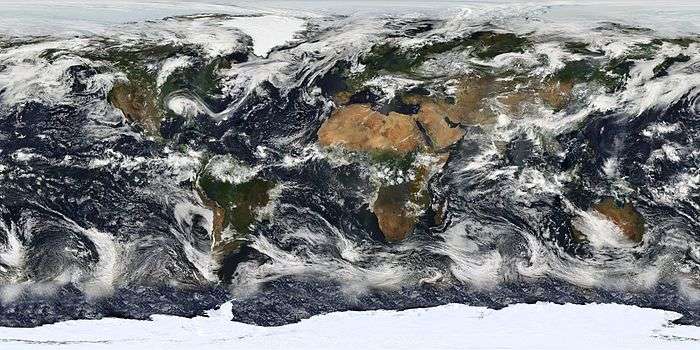
See also
References
- ↑ "MODIS Components". Retrieved 11 August 2015.
- ↑ "MODIS Design". Retrieved 11 August 2015.
- ↑ "MODIS Characterization Support Team". Retrieved 18 July 2015.
- ↑ LU, L., KUENZER, C., WANG, C., GUO, H., Li, Q., 2015: Evaluation of three MODIS-derived Vegetation Index Time Series for Dry land Vegetation Dynamics Monitoring. Remote Sensing, 2015, 7, 7597–7614; doi:10.3390/rs70607597
- ↑ LEINENKUGEL; P., WOLTERS, M., OPPELT, N., KUENZER, C., 2014: Tree cover and forest cover dynamics in the Mekong Basin from 2001 to 2011. Remote Sensing of Environment, Vol. 158, 376–392
- ↑ KLEIN, I., GESSNER, U. and C. KUENZER, 2012: Regional land cover mapping in Central Asia using MODIS time series. Applied Geography 35, 1–16
- ↑ LU, L., KUENZER, C., GUO, H., Li, Q., LONG, T., LI, X., 2014: A Novel Land Cover Classification Map Based on MODIS Time-series in Nanjing, China. Remote Sensing, 6, 3387–3408; doi:10.3390/rs6043387
- ↑ GESSNER, U.; MACHWITZ, M.; ESCH, T.; TILLACK, A.; NAEIMI, V.; KUENZER, C.; DECH, S. (2015): Multi-sensor mapping of West African land cover using MODIS, ASAR and TanDEM-X/TerraSAR-X data. Remote Sensing of Environment. 282–297
- ↑ DIETZ, A., KUENZER, C., and C. CONRAD, 2013: Snow cover variability in Central Asia between 2000 and 2011 derived from improved MODIS daily snow cover products. International Journal of Remote Sensing 34 (11), 3879–3902
- ↑ DIETZ, A., WOHNER, C., and C. KUENZER, 2012: European snow cover characteristics between 2000 and 2011 derived from improved MODIS daily snow cover products. Remote Sensing, 4, 2432–2454, doi:10.3390/rs4082432
- ↑ KUENZER, C, KLEIN, I., ULLMANN; T., FOUFOULA-GEORGIOU, E., BAUMHAUER, R., DECH, S., 2015: Remote Sensing of River Delta Inundation: exploiting the Potential of coarse spatial Resolution, temporally-dense MODIS Time Series. Remote Sensing, 7, 8516–8542
- ↑ KLEIN, I., DIETZ, A., GESSNER, U., DECH, S., KUENZER, C., 2015: Results of the Global WaterPack: a novel product to assess inland water body dynamics on a daily basis. Remote Sensing Letters, Vol. 6, No. 1, 78–87
- ↑ "Shrinking Aral Sea."NASA Earth Observatory. Retrieved: 30 September 2014.
- ↑ "MODIS Active Fire Mapping Program FAQs." United States Forest Service. Retrieved: 30 September 2014.
- ↑ http://modis.gsfc.nasa.gov/data/
- ↑ "MODIS Products Table". Retrieved 2011-06-12.
- ↑ "Direct Broadcast at MODIS Website". Retrieved 2009-06-02.
- ↑ "About Reverb". Retrieved 2011-11-07.
- ↑ "LANCE-MODIS". NASA Goddard Space Flight Center. Retrieved 2014-09-15.
- ↑ "HDF-EOS Tools and Information Center". Retrieved 2009-06-02.
External links
| Wikimedia Commons has media related to NASA MODIS images. |
- Official NASA site
- MODIS bands and spectral ranges (broken link)
- MODIS Images of the Day
- MODIS Image of the Day – Google Gadget referring to MODIS image of the day.
- Gallery of Images of Interest
- MODIS Land Product Subsetting Tool for North America from Oak Ridge National Laboratory
- MODIS Rapid Response system (near real time images)
- NASA OnEarth (Web service for MODIS imagery)
- Visible Earth: Latest MODIS images
- MODIS Sinusoidal: Projection 6842 – MODIS Sinusoidal
- Python: accessing near real-time MODIS images and fire data from NASA’s Aqua and Terra satellites (Python)